1941
JUNE 1941
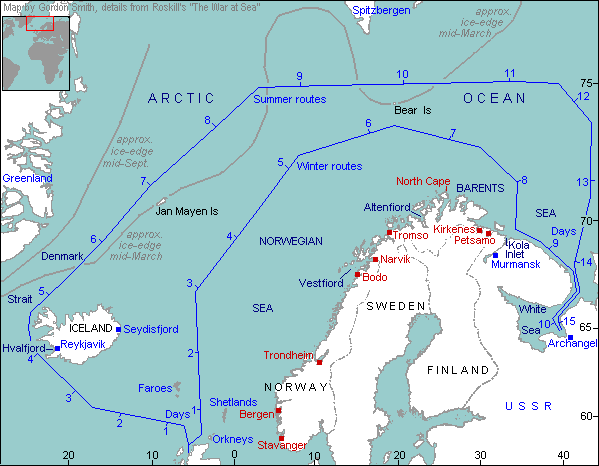
The
invasion
of Russia soon led to the
introduction of the Russian or Arctic
convoys with their
dreadful conditions and after some
months had elapsed,
high losses in men and ships. However,
the Royal Navy's
presence in the Arctic was first made
known in August
when submarines started operating, with
some success
against German shipping supporting the
Axis attack from
Norway towards Murmansk. The port was
never captured.
Conditions with these convoys were at
the very least
difficult. Both summer and winter routes
were close to
good German bases in Norway from which
U-boats, aircraft
and surface ships could operate. In the
long winter
months there was terrible weather and
intense cold, and
in summer, continual daylight. Many
considered that no
ships would get through. The first
convoy sailed in
August and, by the end of the year, over
100 merchantmen
had set out in both directions. Only one
was lost to a
U-boat. In 1942 the picture changed
considerably.
AUGUST
1941
The
first
Russian convoy, 'Dervish', sailed from
Iceland with seven
ships and arrived safely. Carrier
"Argus"
accompanied them to fly off Hurricanes
for Kola.
SEPTEMBER
1941
Russian
convoy PQ1 and the return QP1
both set out
in September. A total of 24 ships were
passed through
without loss by early October
OCTOBER
1941
The
six merchant
ships of Russian convoy PQ2 got
through to Archangel without loss.
NOVEMBER
1941
In
November Russian
convoys PQ3, 4 and 5
and return convoys QP2 and 3
with a total
of 45 ships set out. Three merchantmen
turned back but
the rest got through without loss.
DECEMBER
1941
Three
outward-bound convoys, PQ6, PQ7 and
PQ7B
and one return, QP4 set out in
December with a
total of 31 ships. All but PQ6 arrived
at their
destinations in January, with two ships
returning and one
lost to U-boats.
1942
JANUARY
1942
Destroyer
"MATABELE"
escorting Iceland/Russia convoy PQ8
was sunk off Murmansk on the 17th
by
"U-454". Only two men survived. None of
the
eight merchantmen in the convoy were
lost although one
was damaged by a U-boat torpedo. In two
return convoys in
the month - QP5 and QP6
- 10 ships set out
and arrived safely.
FEBRUARY
1942
In
four convoys
PQ9, PQ10, PQ11 and return QP7,
31 merchantmen arrived safely at their
destinations
without loss.
MARCH
1942
1st-12th
- Convoy PQ12 and Return QP8 - By
now German battleship
"Tirpitz", the ship that dictated Royal
Navy
policies in northern waters for so long,
had been joined
in Norway by pocket battleship "Admiral
Scheer". The next Russia-bound and
return convoys
therefore set out on the same day, the 1st,
so
they could be covered by the Home Fleet
with battleships
"Duke of York", "Renown", "King
George V" and carrier "Victorious". On
the
4th, cruiser "Sheffield"
was
damaged on a mine off Iceland as
she sailed to join the cover force.
Convoys PQ12 and QP8
passed to the southwest of Bear Island
and with
"Tirpitz" reported at sea, the Home
Fleet tried
to place itself between her and the
convoys. There was no
contact between the surface ships, but
on the 9th,
aircraft from "Victorious" attacked but
failed
to hit "Tirpitz" off the Lofoten
Islands. Of
the 31 merchantmen in two convoys, only
one straggler
from QP8 was lost to the German force.
20th
March-3rd April - Convoy PQ13 and
Return QP9 - These
next
two convoys set out around the 20th,
again
covered by the Home Fleet. Off North
Cape on the 24th "U-655" was
rammed
and sunk by minesweeper
"Sharpshooter" escorting QP9. Of the 19
merchantmen in this convoy all reached
Iceland in safety.
PQ13 and its escort, including cruiser
"Trinidad" and destroyers "Eclipse"
and "Fury", were scattered by severe
gales and
heavily attacked. On the 29th
three German
destroyers encountered the escort north
of Murmansk. "Z-26"
was
sunk,
but in the action "Trinidad"
was
hit
and disabled by one of her own
torpedoes. As the cruiser limped towards
Kola Inlet an
attack by "U-585" failed and she was
sunk by
"Fury". Five of the 19 ships with PQ13
were
lost - two to submarines, two to
aircraft, and one by the
destroyers. "Trinidad" reached Russia.
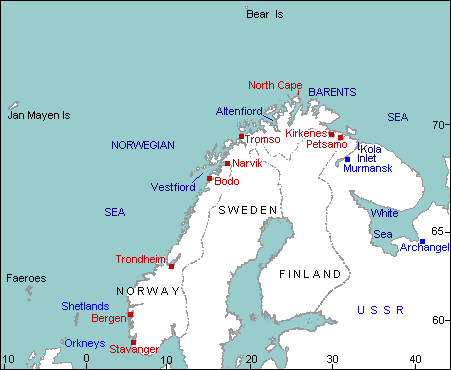
APRIL
1942
During
the month,
Russian convoy PQ14 set out from
Iceland with 24 ships. Only seven
arrived. One was sunk
by a U-boat and another 16 had to turn
back because of
the weather. Return convoy QP10 lost
four of its
16 ships around the same time, two each
to U-boats and
aircraft. Towards the end of the month
convoys PQ15
and QP11 sailed. Both had
cruisers in close
support and PQ15 was covered by units of
the Home Fleet
including battleships "King George V"
and the
American "Washington". On the 30th
the
QP11 cruiser "Edinburgh"
was
torpedoed twice by
"U-456" and had to turn back for
Murmansk. The
story of the PQ15 and QP11 convoys is
taken up in May
MAY
1942
26th
April-7th May - Convoy PQ15 and
Return QP11 - PQ15
sailing for Russia suffered
misfortune twice, On the 1st, battleship
"King George
V" rammed "PUNJABI" one of her escorting
destroyers
and was then damaged by the latter's
depth charges as she
went down with heavy loss of life. On
the 2nd,
minesweeper "Seagull" and Norwegian
destroyer
"St Albans" sank Polish submarine
"JASTRZAB" in error. Three of the
convoy's merchant
ships were lost to torpedo aircraft but
the remaining 22
reached Murmansk by the 5th. QP11
departed Russia on the 28th April and on
the 30th cruiser
"Edinburgh" was torpedoed twice by
U-boat. As
she limped back to Russia yet again,
three German
destroyers attacked QP11, but only
managed to sank a
straggler. They found the cruiser on the
2nd. In a series
of confused fights amidst snow showers
and smokescreens,
"Edinburgh" disabled the "Hermann
Schoemann" by
gunfire, but was then torpedoed for a
third time by
either "Z-24" or "Z-25". Escorting
destroyers "Forester" and "Foresight"
were also
damaged. Both "EDINBURGH" and "HERMANN
SCHOEMANN"
were
scuttled
on the 2nd. The surviving
12 merchantmen of QP11 got through to
Reykjavik, Iceland
on the 7th.
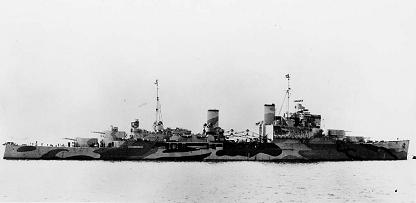
14th/15th
- Cruiser
"Trinidad" (above - Navy Photos)
was damaged escorting PQ13 in March,
and patched up at Murmansk ready for the
homeward
journey. Escort was now provided by four
destroyers and
cover by more cruisers, but on the 14th
she was
heavily attacked from the air and hit by
a Ju88 bomber.
Fires got out of control and "TRINIDAD"
was
scuttled
next day in the cold waters
north of Norway's North Cape.
German
Surface Warships
- In addition to aircraft and U-boats,
the Germans now
had "Tirpitz", "Admiral Scheer",
"Lutzow", "Hipper" and nearly a dozen
big destroyers at Narvik and Trondheim.
With by now
continuous daylight throughout the
journey, the Admiralty
pressed for the convoys to be
discontinued until the days
shortened. For political reasons they
went ahead.
Convoys
PQ16 and QP12
passed through in May. PQ16 started out
for Russian with
35 ships but one returned, six were lost
to heavy
aircraft attack and one to U-boats. QP12
had one return
but the other 14 reach Iceland.
JUNE
1942
Russian
convoys
PQ17 and QP13 set sail
towards the end of the
month.
JULY
1942
27th
June-28th July - Destruction of
Convoy PQ17 - Convoys
PQ17 and return QP13 both
set out on 27th
June. PQ17 left Reykjavik,
Iceland with 36 ships,
of which two returned. The close escort
under Cdr J. E.
Broome included six destroyers and four
corvettes. Two
British and two US cruisers with
destroyers were in
support (Rear-Adm L. H. K. Hamilton),
and distant cover
was given by the Home Fleet (Adm Tovey)
with battleships
"Duke of York" and the US
"Washington", carrier "Victorious",
cruisers and destroyers. The British
Admiralty believed
the Germans were concentrating their
heavy ships in
northern Norway. In fact pocket
battleship
"Lutzow" had run aground off Narvik, but
this
still left battleship "Tirpitz", pocket
battleship "Admiral Scheer" and heavy
cruiser
"Admiral Hipper" - all formidable
adversaries,
which reach Altenfiord on the 3rd. At
this time PQ17 had
just passed to the north of Bear Island,
after which
German aircraft sank three merchantmen.
Fear of attack by
the German ships led the First Sea Lord,
Adm Pound, far
away in London, to decide the fate of
the convoy. In the
evening of the 4th the support cruisers
were ordered to
withdraw and the convoy to scatter.
Unfortunately Adm
Hamilton took the six escorting
destroyers with him. The
merchantmen were now to the north of
North Cape.
Thirty-one try to make for the isolated
islands of Novaya
Zemlya before heading south for Russian
ports. Between
the 5th and 10th July, 20 of them were
lost, half each to
the aircraft and U-boats sent to hunt
them down. Some
sheltered for days off the bleak shores
of Novaya Zemlya.
Eventually 11 survivors and two rescue
ships reached
Archangel and nearby ports between the
9th and 28th. In
fact "Tirpitz" and the other ships did
not
leave Altenfiord until the morning of
the 5th, after the
'convoy was to disperse' order. They
abandoned the sortie
that same day. History suggests the
vital decision on the
future of PQ17 should have been left to
the commanders on
the spot. The US reacted strongly to the
Royal Navy
apparently leaving its merchantmen to
their fate.
Meanwhile all went well with QP13's
35 ships from
Murmansk, until the 5th. Approaching
Iceland through the
Denmark Strait they ran into a British
minefield.
Escorting minesweeper "NIGER" and five
merchant ships were lost.
The rest got in. No more Russian convoys
run until
September..
SEPTEMBER
1942
2nd-26th
- Convoy PQ18 and Return QP14 -
PQ18 left Loch Ewe in
Scotland on the 2nd with over 40
merchantmen. The
hard learnt lessons of PQ17 and previous
convoys were not
forgotten. Close escort was provided by
17 warships plus
escort carrier "Avenger" and two
destroyers.
Two separate forces were in support -
close cover by AA
cruiser "Scylla" and 16 fleet destroyers
under
Rear-Adm R L Burnett, and further out
three heavy
cruisers. More distant cover was by
Vice-Adm Sir Bruce
Fraser with battleships "Anson" and
"Duke
of York", a light cruiser and destroyers
to the
northeast of Iceland. Submarines
patrolled off the
Norwegian Lofoten Islands and northern
Norway. Over 40
major warships were involved. German
heavy ships moved to
Altenfiord but did not sortie. Instead
the attacks were
mounted by bombers and torpedo aircraft
as well as
U-boats. On the 13th, aircraft
torpedoed nine
ships, but next day "Avenger's"
Hurricanes
ensured only one more ship was lost to
air attack. In
total over 40 German aircraft were shot
down by the
convoy's defences. U-boats sank three
merchantmen but
lost three of their number to Adm
Burnett's forces.
Destroyers "Faulknor", "Onslow" and
"Impulsive" sank "U-88", "U-589" and
"U-457" respectively between the 12th
and
16th in the Greenland and Barents
Seas. (Some
sources reverse the identity of "U-88"
and
"U-589"). Escort carrier "Avenger's"
Swordfish from 825 Squadron helped with
the destruction
of "Onslow's" U-boat on the 14th.
Of the
original 40 ships, 27 reached Archangel
on the 17th.
Meanwhile return convoy QP14
with 15 ships sailed
on the 13th to gain the
protection of
"Avenger" and Adm Burnett's AA cruiser
and
destroyer force. On the 20th, to
the west of Bear
Island, minesweeper "LEDA"
was sunk
by "U-435" and support group
destroyer "SOMALI" torpedoed by "U-703".
After
struggling for four days in tow towards
Iceland a gale
blew up and she foundered to the north.
Three merchant
ships were lost to U-boats and the
survivors reached Loch
Ewe on the 26th. In late 1941,
escort carrier
"Audacity" closed the Gibraltar air-gap
for the
first time. "Avenger" had now done the
same for
the Russian route. However, further
convoys havdto be
postponed as ships were transferred in
preparation for
the North African landings.
NOVEMBER
1942
Archangel
to
Loch Ewe, Scotland convoy QP15
with 28 ships
lost two to U-boat attack.
DECEMBER
1942
31st
- Battle of the Barents Sea &
Convoys JW51A and JW51B - After a
three-month gap the first of the
JW convoys set out. JW51 sailed
in two sections. Part
A left Loch Ewe, Scotland on the 15th
with 16
ships bound for Kola Inlet. All arrived
safely on
Christmas Day, the 25th
accompanied by supporting
cruisers "Jamaica" and "Sheffield". JW51B
(14 ships) left on the 22nd escorted
by six
destroyers, a minesweeper and four
smaller vessels under
the command of Capt St. V. Sherbrooke in
"Onslow". Adm Burnett with "Jamaica"
and "Sheffield" joined the convoy south
west of
Bear Island on the 29th to
provide close cover
through the Barents Sea. By now
"Tirpitz",
pocket battleship "Lutzow", heavy
cruiser
"Admiral Hipper", light cruisers
"Koln" and "Nurnberg" and a number of
5in and 5.9in gun destroyers were in
Norwegian waters.
The Admiralty assumed they were for
attacks on Russian
convoys. In fact, they were in Norway
because Hitler
feared invasion. Convoy JW51B
was reported an the 30th
and 8in "Hipper" (Adm Kummetz), 11in
"Lutzow" and six destroyers put to sea
from
Altenfiord to intercept north of North
Cape. Early on the 31st, New
Year's Eve, the British ships were in
four groups (1-4).
The main convoy
(1)
with five remaining 4in or 4.7in
destroyers "Achates", "Onslow",
"Obdurate", "Obedient" and
"Orwell" headed due east. (Some of the
escort
and merchantmen had been scattered by
gales and never
regained the convoy). Northeast of the
convoy, detached
minesweeper "Bramble"
(2)
was
searching
for missing ships. Adm
Burnett's two 6in cruisers
(3) covered
to the north. Further
north still a straggling merchant ship
and escorting
trawler (4)
tried to reach the convoy. Capt
Sherbrooke
planned to use the same tactics as Adm
Vian in the Second
Battle of Sirte and head for the enemy
while the convoy
turned away under smoke. Unfortunately
Adm Kummetz
divided his force in two [1-2]
and planned to attack
from astern on both sides - "Hipper" [1]
and three destroyers in the north
and "Lutzow"
[2] with the other
three in the south.
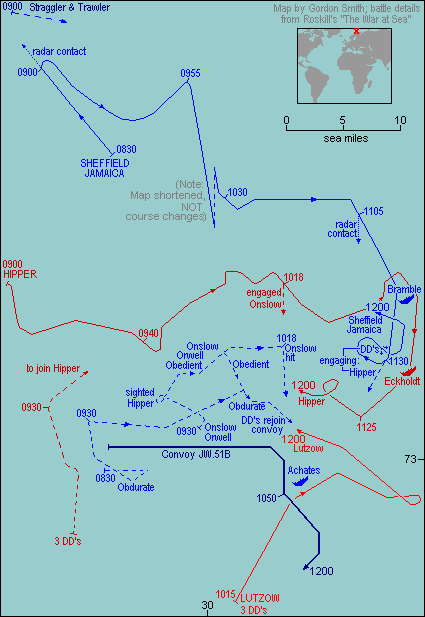
On the 31st
around 09.30,
the action started with "Hipper's" three
destroyers [1]
heading north across the rear of
the convoy
(1), and
opening fire on
"Obdurate". The convoy later turned as
planned,
but south towards "Lutzow"
[2]. Then "Onslow",
Orwell" and Obedient" sighted Hipper"
[1] and held her off
until, at 10.20,
"Onslow" was
hit
and Capt Sherbrooke badly
wounded (Capt Rupert St. V. Sherbrooke
RN was awarded the
Victoria
Cross for gallantry).
Adm Burnett's cruisers (3)
meanwhile, following a radar contact,
had
diverted north towards the straggler and
escort (4).
They only headed towards the
action at 10.00. Still to the
north of the convoy,
"Hipper" [1]
and her destroyers came
across the
hapless "BRAMBLE"
(2)
and sent her to the bottom around 10.40.
They headed south, and 40min later the
8in cruiser [1]
approached JW51B
(1), opened
fire and hit "ACHATES" which sank after
the battle was
over. Lutzow [2]
had
already
come up on the convoy from the
south but did not join battle until 11.45.
She was driven off by the remaining
destroyers. By now
"Jamaica" and "Sheffield"
(3)
had arrived on the scene. They
quickly hit "Hipper"
[1] and sank destroyer
"FRIEDRICH
ECKOLDT".
"Hipper" tried to get back to the convoy
but
again the destroyers skillfully kept her
at bay. By midday
the German ships were withdrawing with
the two cruisers
in pursuit. Contact was shortly lost.
None of the
merchantmen were more than lightly
damaged and all 14
reached Kola on the 3rd January.
Return convoy RA51
left Kola on the 30th December.
After being
supported part of the way by "Jamaica"
and
"Sheffield", the 14 merchant ships were
safely
delivered to Loch Ewe on the 11th
January. When
Hitler learnt the big ships had been
driven off by light
cruisers and destroyers he flew into a
rage and ordered
them all paid off. Grand-Adm Raeder
resigned in protest
and was succeeded as C-in-C, German
Navy, in January by
Adm Doenitz. The paying-off order was
revoked.
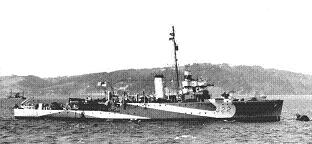
HMS
Britomart, Algerine
minesweeper and
same class as the overwhelmed
"Bramble"
1943
JANUARY
1943
Russian
convoy
JW52 and return RA52 both
set out in
January. Of the 25 ships in the two
convoys, one left
JW52 to return to port, and one
merchantmen with RA52 was
lost to U-boat attacks.
FEBRUARY
1943
Russia-bound
convoy
JW53 sailed with 28 merchantmen.
Six turned
back because of the weather, but the
rest reach Kola
Inlet on the 27th. Return convoy RA53
with 30 ships lost
three to U-boats in March. These were
the last convoys to
or from Russia until November 1943 -
another nine months,
because of the pressure of events in the
North Atlantic
MARCH
- AUGUST 1943
No
convoys ran.
SEPTEMBER
1943
22nd
-
Midget Submarine Attack on Tirpitz
- Battleship
"Tirpitz" posed
such a threat to Russian convoys and
held down so much of
Home Fleet's strength that almost any
measures to
immobilise her were justified. One
gallant attempt was
made in October 1942 when a small
Norwegian fishing
vessel "Arthur", penetrated to within a
few
miles of the battleship in
Trondheimfiord with Chariot human
torpedoes slung
underneath. Just short of the target
they broke away and
all the efforts were in vain. Now it was
the turn of
midget submarines - the X-craft each
with two 2-ton saddle charges. Six
left for northern Norway towed by 'S' or
'T' class
submarines. Two were lost on passage,
but on the 20th
off Altenfiord, "X-5", "X-6" and
"X-7" set out to attack "Tirpitz" and
"X-10" for the Scharnhorst. "X-5"
was
lost and "X-10" was
unable to attack, but "X-6" (Lt Cameron)
and "X-7" (Lt Place) penetrated the
defences
to reach "Tirpitz" laying in Kaafiord at
the
far end of Altenfiord. Both dropped
their charges under
or near the battleship before they sank
and some of their
crews escaped. "Tirpitz" managed to
shift her position slightly, but
not enough to avoid damage when the
charges went up. She
was out of action for six months. Lt
Donald Cameron RNR
and Lt Basil Place RN were awarded the
Victoria Cross.
NOVEMBER
1943
For
the first
time
since March 1943, Russian convoys sailed
- setting
out and arriving at the end of the month
and in early
December. Convoys JW54A and JW54B
to Kola
Inlet, and return RA54A and RA54B
passed
through a total of 54 ships without
loss.
DECEMBER
1943
26th
- The Battle of North Cape and
Convoy JW55B - Russian
convoys were still sailing in two
sections. JW55A left Loch Ewe,
Scotland on the 12th
and arrived safely with all 19 merchant
ships on the 20th.
Adm Fraser with "Duke of York" went
right
through to Russia for the first time
before returning to
Iceland.
Convoy JW55B,
also with 19 ships, sailed for Russia
on the 20th.
>>>
<<<
Three
days later return convoy RA55A
(22
ships) sets out.
Cover for
both convoys
through the Barents Sea was to be
provided by Vice-Adm R.
L. Burnett with cruisers "Belfast",
"Norfolk" and "Sheffield" (1)
which left Kola Inlet on the same
day as RA55A - the 23rd. The
Admiralty expected
the 11in-gunned battlecruiser
"Scharnhorst" to
attack the convoys and Adm Fraser with
"Duke of
York" and cruiser "Jamaica" (2)
left
Iceland
and headed for the Bear
Island area. "Scharnhorst" (Rear-Adm
Bey) and
five destroyers [1]
sailed
from
Altenfiord late on the 25th,
Christmas Day. Early next morning JW55B
was 50
miles south of Bear Island, the weather
stormy, as the
Germans headed north to intercept.
Meanwhile Adm Fraser
(2) was
200 miles away to the southwest and
Adm Burnett's cruisers (1)
were approaching the convoy from
the
east. At 07.30 on the 26th
the German
destroyers were detached to search for
the convoy, failed
to make contact and were later ordered
home. They played
no part in the battle.